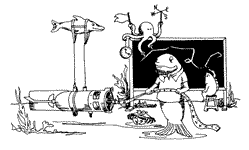|
|
|
| |
Home
Abstracts
Technical Program
Schedule of presenters and events.
Accomodations
Reserving your room at the Bahia Hotel
Order the Proceedings
Information and order form.
Committee and Contact Info
Who and how to contact the presenters and organizers.
|
|
| |
|
|
MWAVES - Software for Calculating the Directional Spectra and
Statistical Properties of the Wave Field from MAVS-3 Triplet
Measurements
Archie T. Morrison III1 and Eugene A. Terray2
1Falmouth Technology Park
121 Bernard E. Saint Jean Drive
East Falmouth, MA USA
02536
2Woods Hole Oceanographic Institution
MS #11
Woods Hole, MA USA
02543
Real-time knowledge of the directional spectra and other statistical
properties of the wave environment in coastal waters and harbors is
critically important information for those involved in marine
operations. Historical and real-time measurements are also important
for coastal engineering applications and for investigations into coastal
processes. The spectral and statistical properties of the
wave field can be calculated from accurate time-series of "triplet"
measurements, either the three horizontal and vertical components
of the velocity or the pressure and the two horizontal components
of the velocity. MAVS-3, the Modular Acoustic Velocity Sensor, can
make the necessary measurements in either form and can telemeter data
to shore in real-time or store measurements internally for later processing.
Accurately and reliably calculating the spectral and statistical
properties of a complex stochastic process with many degrees of freedom
is, however, inherently a non-trivial task. This paper describes MWAVES,
a software package that performs these calculations and presents the
results to the operator in easily interpreted graphical and numeric
forms. The kernal of routines that perform the calculation is fast
and the graphical user interface through which the operator controls
processing is full-featured and easy to use. A time history of the
evolving statistical properties of the wave environment can be logged
and plotted and all graphs can be stored in standard formats for later
recall. MWAVES was developed for use with MAVS-3 data, but it has
been successfully used with MAVS-2 measurements and can be applied
to the triplet data of other instruments.
Submitted on January 22, 2003
|
